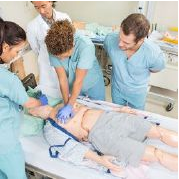The Importance of CPR
CPR can save the lives of loved ones or strangers. Chest compression only CPR is very effective at saving lives and it is always better to attempt to perform CPR than not.
Cardiopulmonary resuscitation, or CPR, is a lifesaving tool that has been successfully used since the Paris Academy of Sciences recommended mouth-to-mouth resuscitation for drowning victims in 1740.
Human life can be fragile and it could be up to us to step in and save the life of a loved one or even a complete stranger. CPR is a stopgap measure that can prevent brain damage and help keep a person from dying until medical assistance arrives.
There is a certain amount of bystander reluctance when a person is in need of CPR, but the Australian Resuscitation Council advises that any attempt at resuscitation is better than none. Part of this reluctance is fear of disease transmission, but a systematic review found no reports of transmission of hepatitis B or C, HIV or cytomegalovirus during training or actual CPR, as long as high-risk activities such as intravenous cannulation were not performed.[1]
A report in The Journal of the American Medical Association has shown that chest compression only CPR saves more lives than an alternating compression and rescue breathing technique. First, compression-only CPR is easier to learn and remember, and because it is less intimidating bystanders are more likely to perform it. Second, bystanders are often reluctant to perform mouth to mouth resuscitation on strangers. Third, stopping compressions, even just for rescue breathing, can disrupt blood circulation enough to compromise the benefits of CPR.
 The chest compressions of CPR circulate blood to provide oxygen to the body and brain. There is enough oxygen in the blood to keep the brain and organs alive for a few minutes, but if it is not circulating, it is of no use to the victim.
The chest compressions of CPR circulate blood to provide oxygen to the body and brain. There is enough oxygen in the blood to keep the brain and organs alive for a few minutes, but if it is not circulating, it is of no use to the victim.
CPR is useful in cases of heart attack or drowning. The American Red Cross lists the following reasons for learning CPR:
- Drowning is the leading cause of accidental death for children ages 1 to 4.
- It takes just one minute for a child to drown.
- 88 percent of all cardiac arrests happen at home.
- Only 9 to 10 percent of cardiac arrest victims survive because bystanders do not know CPR. This number could rise dramatically.
- One quarter of the 30,000 deaths from sudden cardiac arrest could be prevented with widespread CPR training, according to the Heart Association.
With these shocking statistics, it’s no wonder that health advocacy groups around the world call for greater CPR training of the general population. Given that 88 percent of all cardiac arrests happen at home, the life you save could very likely be the life of a loved one. Keep in mind that any attempt at CPR is better than none.
While CPR does not guarantee a person will survive, it does give them a greater chance for survival when there would have been none.
If you are not certain whether a person requires CPR, begin chest compressions. If they do not require your assistance, they will push you away or otherwise respond to your attempts. You won’t cause them harm if they are not in cardiac arrest.
[1] Nolan, JP et al. Part 1: executive summary: 2010 International Consensus on Cardiopulmonary Resuscitation and Emergency Cardiovascular Care Science With Treatment Recommendations. Resuscitation 2010;81:el-e25.



















